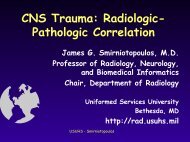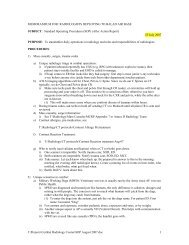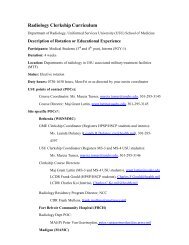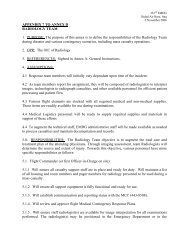Common Adult Brain Tumors - Radiology - Uniformed Services ...
Common Adult Brain Tumors - Radiology - Uniformed Services ...
Common Adult Brain Tumors - Radiology - Uniformed Services ...
You also want an ePaper? Increase the reach of your titles
YUMPU automatically turns print PDFs into web optimized ePapers that Google loves.
USU - The Nation’s Medical School<br />
USU – Learning to Care for Those in Harm’s Way<br />
<strong>Radiology</strong> - http://rad.medpix.net<br />
<strong>Common</strong> <strong>Adult</strong><br />
<strong>Brain</strong> <strong>Tumors</strong><br />
James G. Smirniotopoulos, M.D.<br />
<strong>Radiology</strong> and Radiological Sciences<br />
<strong>Uniformed</strong> <strong>Services</strong> University<br />
of the Health Sciences<br />
Bethesda, MD<br />
jsmirnio@rad.usuhs.mil<br />
<strong>Radiology</strong> - http://rad.usuhs.mil<br />
Educational Objectives<br />
• Distinguish Intraaxial from Extraaxial<br />
• Circumscribed vs. Diffuse Astrocytoma<br />
• Grades of Diffuse Astrocytoma<br />
• Natural Hx of Astrocytoma<br />
• Limitations of Surgery for Diffuse Astro<br />
• Primary CNS Lymphoma<br />
USU – Learning to Care for Those in Harm’s Way<br />
USU – Learning to Care for Those in Harm’s Way<br />
<strong>Radiology</strong> - http://rad.usuhs.mil<br />
<strong>Brain</strong> Neoplasia: Frequency*<br />
~ 2/3 are<br />
Primary CNS<br />
<strong>Tumors</strong><br />
~ 1/3 are<br />
Metastatic<br />
CNS <strong>Tumors</strong><br />
Levin VA et al.<br />
Cancer: Principles & Practice of Oncology.<br />
1997: 2022 - 2082.<br />
<strong>Radiology</strong> - http://rad.usuhs.mil<br />
Primary CNS Neoplasms<br />
• Primary<br />
– Intraaxial<br />
• Astrocytoma (Glioma)<br />
– Circumscribed<br />
– Diffuse<br />
• Lymphoma<br />
• Neuronal<br />
– Extraaxial<br />
• Meningioma<br />
• Schwannoma<br />
• Pituitary<br />
USU – Learning to Care for Those in Harm’s Way<br />
<strong>Radiology</strong> - http://rad.usuhs.mil<br />
Lesion Location<br />
Where is the lesion <br />
–Intraaxial<br />
–Extraaxial<br />
USU – Learning to Care for Those in Harm’s Way<br />
<strong>Radiology</strong> - http://rad.usuhs.mil<br />
WHO Classification of <strong>Tumors</strong><br />
<strong>Tumors</strong> of neuroepithelium<br />
Astrocytomas<br />
Oligodendrogliomas<br />
Mixed gliomas<br />
Ependymomas<br />
Glial tumors- uncertain origin<br />
Neuronal tumors & mixed neuronal glial tumors<br />
Embryonal tumors<br />
Lymphomas & hematopoietic tumors<br />
Metastases<br />
Gliomas
USU – Learning to Care for Those in Harm’s Way<br />
<strong>Radiology</strong> - http://rad.usuhs.mil<br />
Primary CNS Neoplasms<br />
• Primary<br />
– Intraaxial<br />
• Astrocytoma (Glioma)<br />
– Circumscribed<br />
– Diffuse<br />
• Lymphoma<br />
• Neuronal<br />
– Extraaxial<br />
• Meningioma<br />
• Schwannoma<br />
• Pituitary<br />
Circumscribed Astrocytoma<br />
USU – Learning to Care for Those in Harm’s Way<br />
USU – Learning to Care for Those in Harm’s Way<br />
<strong>Radiology</strong> - http://rad.usuhs.mil<br />
Pilocytic Astrocytoma<br />
<strong>Radiology</strong> - http://rad.usuhs.mil<br />
Pilocytic Astrocytoma<br />
PILOCYTIC ASTROCYTOMA<br />
<strong>Radiology</strong><br />
• Cerebellum, Diencephalon<br />
– rare in BS or Cerebrum<br />
• Majority have significant “cyst”<br />
– “Cyst and Mural Nodule”<br />
• part of lining does NOT enhance<br />
– Nodule may be heterogeneous<br />
– Exceptional purely solid<br />
• Nodule NOT hyperdense<br />
• Calcification in 5-25%<br />
PATHOLOGY<br />
• Biphasic pattern<br />
– dense pilocytic glia<br />
– Rosenthal fibers<br />
– loose microcystic areas<br />
• No necrosis<br />
• Low grade<br />
• Abnormal capillaries<br />
– allow enhancement<br />
– fluid production
USU – Learning to Care for Those in Harm’s Way<br />
<strong>Radiology</strong> - http://rad.usuhs.mil<br />
Primary CNS Neoplasms<br />
• Primary<br />
– Intraaxial<br />
• Astrocytoma (Glioma)<br />
– Circumscribed<br />
– Diffuse<br />
• Lymphoma<br />
• Neuronal<br />
– Extraaxial<br />
• Meningioma<br />
• Schwannoma<br />
• Pituitary<br />
Diffuse Astrocytoma<br />
USU – Learning to Care for Those in Harm’s Way<br />
<strong>Radiology</strong> - http://rad.usuhs.mil<br />
Astrocyte Mutation<br />
• Normal Astrocyte<br />
• Neoplastic<br />
• Anaplastic<br />
•GBM<br />
Deletions:<br />
17 p P53<br />
22q NF2<br />
WHO Gr 2 Gr 3 Gr 4 GBM<br />
Deletions:<br />
13q RB<br />
19q<br />
10<br />
Deletions:<br />
10 PTEN/MMAC1<br />
9p P16,P15.P14<br />
USU – Learning to Care for Those in Harm’s Way<br />
<strong>Radiology</strong> - http://rad.usuhs.mil<br />
Diffuse Astrocytoma:<br />
Enlarged Hemisphere<br />
Excess<br />
production of:<br />
PDGF<br />
Excess<br />
production of:<br />
CDK4<br />
Excess<br />
production of:<br />
EGFR<br />
VEGF<br />
USU – Learning to Care for Those in Harm’s Way<br />
<strong>Radiology</strong> - http://rad.usuhs.mil<br />
WHO GR 4<br />
WHO GR 3<br />
WHO GR 2<br />
Diffuse Astrocytoma<br />
Normal<br />
USU – Learning to Care for Those in Harm’s Way<br />
<strong>Radiology</strong> - http://rad.usuhs.mil<br />
Astrocytoma WHO Gr 2<br />
• Increased brain volume<br />
– Cellularity of white matter<br />
• NO Neovascularity<br />
– Not allowed by WHO grading<br />
– Intact normal vessels<br />
– No enhancement<br />
– No vasogenic edema<br />
• Homogeneous<br />
– Microcystic change
USU – Learning to Care for Those in Harm’s Way<br />
USU – Learning to Care for Those in Harm’s Way<br />
<strong>Radiology</strong> - http://rad.usuhs.mil<br />
Gliomatosis Cerebri<br />
<strong>Radiology</strong> - http://rad.usuhs.mil<br />
White Matter Tracts<br />
USU – Learning to Care for Those in Harm’s Way<br />
<strong>Radiology</strong> - http://rad.usuhs.mil<br />
Gliomatosis Cerebri<br />
USU – Learning to Care for Those in Harm’s Way<br />
<strong>Radiology</strong> - http://rad.usuhs.mil<br />
“Gliomatosis Cerebri” = Diffuse<br />
Astrocytoma<br />
CHO<br />
Cr<br />
NAA <br />
{<br />
USU – Learning to Care for Those in Harm’s Way<br />
USU – Learning to Care for Those in Harm’s Way<br />
<strong>Radiology</strong> - http://rad.usuhs.mil<br />
<strong>Brain</strong>stem Astrocytoma<br />
<strong>Radiology</strong> - http://rad.usuhs.mil<br />
<strong>Brain</strong>stem Astrocytoma<br />
WHO Gr 2 Gr 3 Gr 4 GBM
USU – Learning to Care for Those in Harm’s Way<br />
USU – Learning to Care for Those in Harm’s Way<br />
<strong>Radiology</strong> - http://rad.usuhs.mil<br />
Diffuse Astrocytoma<br />
<strong>Radiology</strong> - http://rad.usuhs.mil<br />
Diffuse Astrocytoma<br />
USU – Learning to Care for Those in Harm’s Way<br />
USU – Learning to Care for Those in Harm’s Way<br />
<strong>Radiology</strong> - http://rad.usuhs.mil<br />
Astrocytoma: Microcystic change<br />
<strong>Radiology</strong> - http://rad.usuhs.mil<br />
Primary CNS Neoplasms<br />
• Primary<br />
– Intraaxial<br />
• Astrocytoma (Glioma)<br />
– Circumscribed<br />
– Diffuse<br />
• Lymphoma<br />
• Neuronal<br />
– Extraaxial<br />
• Meningioma<br />
• Schwannoma<br />
• Pituitary<br />
USU – Learning to Care for Those in Harm’s Way<br />
<strong>Radiology</strong> - http://rad.usuhs.mil<br />
Astrocytoma WHO Gr 4<br />
• Glioblastoma multiforme<br />
• Aggressive hypervascular mass<br />
– Abnormal arteries and veins<br />
– “Glomeruloid” capillaries<br />
– Incr. rCBV, rCBF, short MTT<br />
– Absent BBB<br />
• Heterogeneous<br />
– Necrosis, vascular rim with tumor<br />
– Surrounding edema and tumor<br />
• Deceptive lesion<br />
– Looks focal … but is diffusely infiltrating<br />
USU – Learning to Care for Those in Harm’s Way<br />
<strong>Radiology</strong> - http://rad.usuhs.mil<br />
Glioblastoma Multiforme
USU – Learning to Care for Those in Harm’s Way<br />
USU – Learning to Care for Those in Harm’s Way<br />
<strong>Radiology</strong> - http://rad.usuhs.mil<br />
T2<br />
Glioblastoma Multiforme<br />
T1-Gd<br />
<strong>Radiology</strong> - http://rad.usuhs.mil<br />
Diffuse Astrocytoma Spread<br />
• We all see the enhancing<br />
hypercellular and hypervascular RIM<br />
• Microscopically, cells spread through<br />
the white matter<br />
• Corona of vasogenic edema has tumor<br />
• But, tumor may extend beyond area<br />
of T2 abnormality<br />
• MRS, DTI, Anisotropy may help<br />
USU – Learning to Care for Those in Harm’s Way<br />
USU – Learning to Care for Those in Harm’s Way<br />
<strong>Radiology</strong> - http://rad.usuhs.mil<br />
<strong>Radiology</strong> - http://rad.usuhs.mil<br />
Pseudopalisading Necrosis<br />
USU – Learning to Care for Those in Harm’s Way<br />
USU – Learning to Care for Those in Harm’s Way<br />
<strong>Radiology</strong> - http://rad.usuhs.mil<br />
Pseudopalisading<br />
<strong>Radiology</strong> - http://rad.usuhs.mil<br />
GBM: 5-15% 5<br />
are Multifocal
USU – Learning to Care for Those in Harm’s Way<br />
USU – Learning to Care for Those in Harm’s Way<br />
<strong>Radiology</strong> - http://rad.usuhs.mil<br />
Terrorist Cells Infiltrate <strong>Brain</strong><br />
GBM<br />
<strong>Radiology</strong> - http://rad.usuhs.mil<br />
GBM on Surface<br />
USU – Learning to Care for Those in Harm’s Way<br />
Early Draining Veins<br />
USU – Learning to Care for Those in Harm’s Way<br />
Glioblastoma Multiforme<br />
<strong>Radiology</strong> - http://rad.usuhs.mil<br />
<strong>Radiology</strong> - http://rad.usuhs.mil<br />
USU – Learning to Care for Those in Harm’s Way<br />
<strong>Radiology</strong> - http://rad.usuhs.mil<br />
Glioblastoma Multiforme<br />
USU – Learning to Care for Those in Harm’s Way<br />
New Tools for Grading and Staging<br />
<strong>Radiology</strong> - http://rad.usuhs.mil<br />
• <strong>Radiology</strong><br />
– Perfusion - rCBV<br />
– Diffusion and DTI<br />
– Spectroscopy<br />
– PET/SPECT<br />
– Monoclonal Ab.<br />
• Pathology<br />
– Labeling Index<br />
– Chromosomes<br />
– Histochemical<br />
– Electron<br />
Microscopy
USU – Learning to Care for Those in Harm’s Way<br />
USU – Learning to Care for Those in Harm’s Way<br />
<strong>Radiology</strong> - http://rad.usuhs.mil<br />
MR Perfusion Imaging<br />
*<br />
Courtesy of James Provenzale, Duke University<br />
*<br />
<strong>Radiology</strong> - http://rad.usuhs.mil<br />
DTI and Tumor Imaging<br />
T2<br />
DTI<br />
From: J. Burdette and Neeraj Chepuri, WFU<br />
USU – Learning to Care for Those in Harm’s Way<br />
USU – Learning to Care for Those in Harm’s Way<br />
DTI and Tumor Imaging<br />
GBM Corpus Callosum<br />
<strong>Radiology</strong> - http://rad.usuhs.mil<br />
<strong>Radiology</strong> - http://rad.usuhs.mil<br />
Schematic<br />
DTI<br />
From: J. Burdette and Neeraj Chepuri, WFU<br />
USU – Learning to Care for Those in Harm’s Way<br />
USU – Learning to Care for Those in Harm’s Way<br />
Primary CNS Neoplasms<br />
Deep Periventricular Lesions<br />
<strong>Radiology</strong> - http://rad.usuhs.mil<br />
• Primary<br />
– Intraaxial<br />
• Astrocytoma (Glioma)<br />
– Circumscribed<br />
– Diffuse<br />
• Lymphoma<br />
• Neuronal<br />
– Extraaxial<br />
• Meningioma<br />
• Schwannoma<br />
• Pituitary<br />
<strong>Radiology</strong> - http://rad.usuhs.mil<br />
T2W<br />
Courtesy V. Mathews, IA<br />
FLAIR
USU – Learning to Care for Those in Harm’s Way<br />
<strong>Radiology</strong> - http://rad.usuhs.mil<br />
PCNSL: Immunocompetent<br />
USU – Learning to Care for Those in Harm’s Way<br />
<strong>Radiology</strong> - http://rad.usuhs.mil<br />
CNS Lymphoma<br />
• Usually Parenchymal and paracentral<br />
– HUGS the Ventricles<br />
• Small Round Blue-cell Tumor<br />
– CT => Fluffy high density lesions<br />
– MR => Gray matter (or lower) Signal<br />
• Multifocal<br />
• Rings are undulating and irregular<br />
•Hypermetabolic(SPECT, Thallium)<br />
T1-non<br />
T2<br />
USU – Learning to Care for Those in Harm’s Way<br />
USU – Learning to Care for Those in Harm’s Way<br />
<strong>Radiology</strong> - http://rad.usuhs.mil<br />
PCNSL<br />
<strong>Radiology</strong> - http://rad.usuhs.mil<br />
Micro Pathology<br />
• DENSELY CELLULAR<br />
• Perivascular infiltration<br />
• Increased RETICULIN fibers<br />
• HIGH N/C (nuclear/cytoplasm)<br />
• Small Round Blue Cell Tumor<br />
• High attenuation/low signal intensity<br />
USU – Learning to Care for Those in Harm’s Way<br />
USU – Learning to Care for Those in Harm’s Way<br />
<strong>Radiology</strong> - http://rad.usuhs.mil<br />
<strong>Radiology</strong> - http://rad.usuhs.mil
USU – Learning to Care for Those in Harm’s Way<br />
<strong>Radiology</strong> - http://rad.usuhs.mil<br />
Small Round Blue Cell Tumor<br />
Perivascular<br />
Infiltrate<br />
USU – Learning to Care for Those in Harm’s Way<br />
<strong>Radiology</strong> - http://rad.usuhs.mil<br />
CT - Hyperdense<br />
USU – Learning to Care for Those in Harm’s Way<br />
MR - Hypointense<br />
USU – Learning to Care for Those in Harm’s Way<br />
RIM PHOMA<br />
<strong>Radiology</strong> - http://rad.usuhs.mil<br />
<strong>Radiology</strong> - http://rad.usuhs.mil<br />
USU – Learning to Care for Those in Harm’s Way<br />
<strong>Radiology</strong> - http://rad.usuhs.mil<br />
Rimphoma:<br />
It HUGS the Ventricles<br />
USU – Learning to Care for Those in Harm’s Way<br />
<strong>Radiology</strong> - http://rad.usuhs.mil<br />
RIM PHOMA
USU – Learning to Care for Those in Harm’s Way<br />
<strong>Radiology</strong> - http://rad.usuhs.mil<br />
PCNSL: Nl vs. AIDS<br />
USU – Learning to Care for Those in Harm’s Way<br />
<strong>Radiology</strong> - http://rad.usuhs.mil<br />
Lymphoma - Hypointense<br />
T1-gad<br />
T1-gad<br />
USU – Learning to Care for Those in Harm’s Way<br />
<strong>Radiology</strong> - http://rad.usuhs.mil<br />
Lymphoma - Undulating<br />
USU – Learning to Care for Those in Harm’s Way<br />
<strong>Radiology</strong> - http://rad.usuhs.mil<br />
Lymphoma - Undulating<br />
USU – Learning to Care for Those in Harm’s Way<br />
<strong>Radiology</strong> - http://rad.usuhs.mil<br />
1 mon.<br />
Relapse after Tx<br />
2 mon.<br />
3 mon.













